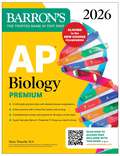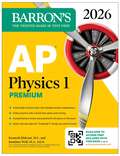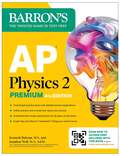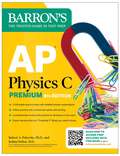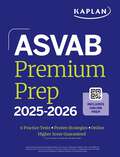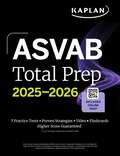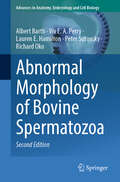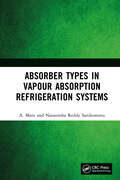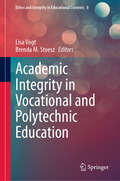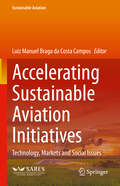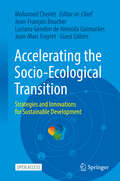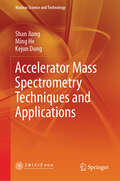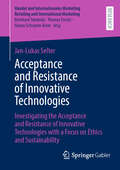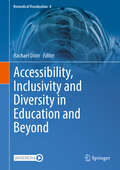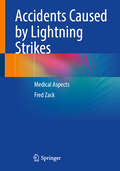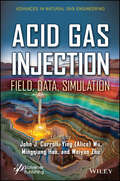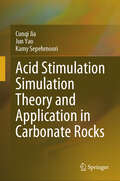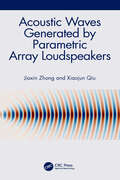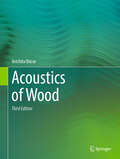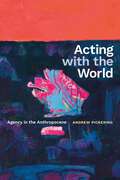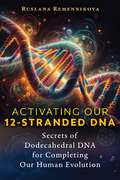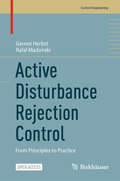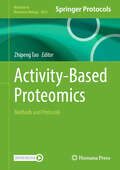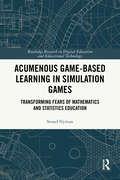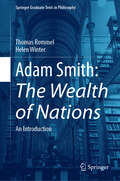- Table View
- List View
AP Biology Premium, 2026: Prep Book with 6 Practice Tests + Comprehensive Review + Online Practice (Barron's AP Prep)
by Mary Wuerth Barron's Educational SeriesBe prepared for exam day with Barron&’s. Trusted content from AP experts!Barron&’s AP Biology Premium, 2026 includes in‑depth content review and practice ALIGNED TO THE NEW COURSE FRAMEWORK. It&’s the only book you&’ll need to be prepared for exam day. Written by Experienced Educators Learn from Barron&’s‑‑all content is written and reviewed by AP experts Build your understanding with comprehensive review tailored to the most recent exam Get a leg up with tips, strategies, and study advice for exam day‑‑it&’s like having a trusted tutor by your side Be Confident on Exam Day Sharpen your test‑taking skills with 6 full‑length practice tests‑‑2 in the book and 4 more online–plus detailed answer explanations for all questions Strengthen your knowledge with in‑depth review covering all units on the AP Biology exam Reinforce your learning with multiple‑choice and short and long free‑response practice questions in each chapter that mirror the format of actual exam questions and are accompanied by clear answers and explanations Expand your understanding with a review of the major statistical tests and lab experiments that will enhance your scientific thinking skills Robust Online Practice Continue your practice with 4 full‑length practice tests on Barron&’s Online Learning Hub Simulate the exam experience with a timed test option Deepen your understanding with detailed answer explanations and expert advice Gain confidence with scoring to check your learning progress Power up your study sessions with Barron's AP Biology on Kahoot!‑‑additional, free practice to help you ace your exam! Publisher's Note: Products purchased from 3rd party sellers are not guaranteed by the publisher for quality, authenticity, or access to any online entities included with the product.
AP Physics 1 Premium, 2026: Prep Book with 4 Practice Tests + Comprehensive Review + Online Practice (Barron's AP Prep)
by Kenneth Rideout M.S. Jonathan Wolf M.A. Ed. M Barron's Educational SeriesBe prepared for exam day with Barron&’s. Trusted content from AP experts! Barron&’s AP Physics 1 Premium, 2026 is fully revised for the latest course and exam updates and includes in‑depth content review and practice. It&’s the only book you&’ll need to be prepared for exam day.Written by Experienced Educators Learn from Barron&’s‑‑all content is written and reviewed by AP experts Build your understanding with comprehensive review tailored to the most recent exam Get a leg up with tips, strategies, and study advice for exam day‑‑it&’s like having a trusted tutor by your side Be Confident on Exam Day Sharpen your test‑taking skills with 4 full‑length practice tests–2 in the book and 2 more online that mirror the latest exam format and question types plus detailed answer explanations for all questions–plus detailed answer explanations for all questions Strengthen your knowledge with in‑depth review covering all recent course updates and the latest units on the AP Physics 1 exam Determine what your strengths are by taking a short diagnostic test and then reinforce your learning by answering a series of practice questions at the end of each chapter Reinforce your learning by answering a series of multiple-choice and free-response practice questions at the end of each chapter Online Practice Continue your practice with 2 full‑length practice tests on Barron&’s Online Learning Hub Simulate the exam experience with a timed test option Deepen your understanding with detailed answer explanations and expert advice Gain confidence with scoring to check your learning progress Publisher's Note: Products purchased from 3rd party sellers are not guaranteed by the publisher for quality, authenticity, or access to any online entities included with the product.
AP Physics 2 Premium, Fourth Edition: Prep Book with 4 Practice Tests + Comprehensive Review + Online Practice (Barron's AP Prep)
by Kenneth Rideout M.S. Jonathan Wolf M.A. Ed. M Barron's Educational SeriesBe prepared for exam day with Barron&’s. Trusted content from AP experts! Barron&’s AP Physics 2 Premium, Fourth Edition is fully revised for the latest course and exam updates and includes in‑depth content review and practice. It&’s the only book you&’ll need to be prepared for exam day.Written by Experienced Educators Learn from Barron&’s‑‑all content is written and reviewed by AP experts Build your understanding with comprehensive review tailored to the most recent exam Get a leg up with tips, strategies, and study advice for exam day‑‑it&’s like having a trusted tutor by your side Be Confident on Exam Day Sharpen your test‑taking skills with 4 full‑length practice tests–2 in the book and 2 more online–that mirror the latest exam format and question types plus detailed answer explanations for all questions Strengthen your knowledge with in‑depth review covering all recent course updates and the latest units on the AP Physics 2 exam Determine what your strengths are by taking a short diagnostic test and then reinforce your learning by answering a series of practice questions at the end of each chapter Enhance your scientific thinking skills by reviewing dozens of sample problems with clear solutions, hundreds of diagrams that illustrate key concepts, and end-of-chapter summaries of all major topics Robust Online Practice Continue your practice with 2 full‑length practice tests on Barron&’s Online Learning Hub Simulate the exam experience with a timed test option Deepen your understanding with detailed answer explanations and expert advice Gain confidence with scoring to check your learning progress Publisher's Note: Products purchased from 3rd party sellers are not guaranteed by the publisher for quality, authenticity, or access to any online entities included with the product.
AP Physics C Premium, Eighth Edition: 4 Practice Tests + Comprehensive Review + Online Practice (Barron's AP Prep)
by Robert A. Pelcovits Ph.D. Joshua Farkas M.D. Barron's Educational SeriesBe prepared for exam day with Barron&’s. Trusted content from AP experts! Barron&’s AP Physics C Premium, Eighth Edition is fully revised for the latest course and exam updates and includes in‑depth content review and practice. It&’s the only book you&’ll need to be prepared for exam day.Written by Experienced Educators Learn from Barron&’s‑‑all content is written and reviewed by AP experts Build your understanding with comprehensive review tailored to the most recent exams Get a leg up with tips, strategies, and study advice for exam day‑‑it&’s like having a trusted tutor by your side Be Confident on Exam Day Sharpen your test‑taking skills with 4 full‑length practice tests–3 in the book, including a diagnostic test to target your studying, and 1 more online–that mirror the latest exam format and question types plus detailed answer explanations for all questions Strengthen your knowledge with in‑depth review covering all recent course updates and the latest units on both the AP Physics C: Mechanics and AP Physics C: Electricity and Magnetism Exams Reinforce your learning with multiple-choice and free-response practice questions at the end of each chapter Enhance your problem-solving skills by reviewing hundreds of examples and detailed solutions that cover all frequently tested topics Online Practice Continue your practice with 1 full‑length practice test on Barron&’s Online Learning Hub Simulate the exam experience with a timed test option Deepen your understanding with detailed answer explanations and expert advice Gain confidence with scoring to check your learning progress Publisher's Note: Products purchased from 3rd party sellers are not guaranteed by the publisher for quality, authenticity, or access to any online entities included with the product.
ASVAB Premium Prep 2025-2026 (Kaplan Test Prep)
by Kaplan Test PrepASVAB Premium Prep 2025-2026: Your Pathway to Military SuccessWhy Choose ASVAB Premium Prep 2025-2026?Comprehensive Coverage: Our guide offers thorough coverage of all nine ASVAB test sections, including General Science, Arithmetic Reasoning, Word Knowledge, Paragraph Comprehension, Mathematics Knowledge, Electronics Information, Auto and Shop Information, Mechanical Comprehension, and Assembling Objects. You'll have all the content you need to master each section of the test. Expert Strategies: Developed by seasoned ASVAB tutors and military professionals, our test-taking strategies are designed to help you approach each question with confidence. Learn the tips and tricks that can boost your score and ensure you perform at your best on test day. Extensive Practice Materials: Practice is crucial for ASVAB success, and ASVAB Premium Prep 2025-2026 provides: 6 full-length practice tests, available in the book and online, to simulate the actual exam experience. Over 1000+ practice questions with detailed explanations, helping you understand your mistakes and learn from them. Drills and exercises for each test section to reinforce your skills and build your confidence. Customizable Study Plans: Whether you have several months or just a few weeks to prepare, our flexible study plans adapt to your schedule and learning style. Maximize your study time with a plan tailored to your needs and goals. Online Resources: Enhance your preparation with our comprehensive online platform, featuring interactive tutorials, video lessons, and progress tracking tools. Stay motivated and on track with resources designed to support your learning every step of the way. Updated for 2025-2026: Stay ahead with the most current information. Our guide is meticulously updated to reflect the latest changes and trends in the ASVAB exam, ensuring you're studying the most accurate and relevant material. Why It Stands Out:ASVAB Premium Prep 2025-2026 is more than just a study guide; it's a comprehensive preparation system designed to help you succeed. With extensive content coverage, expert strategies, abundant practice materials, and advanced online resources, it offers unparalleled value for aspiring military personnel. Choose ASVAB Premium Prep 2025-2026 and take the first step towards a successful military career. With our guide, you'll be well-prepared to achieve your best possible ASVAB scores and secure your place in the armed forces.
ASVAB Total Prep 2025-2026 (Kaplan Test Prep)
by Kaplan Test PrepASVAB Total Prep 2025-2026: Your Complete Guide to ASVAB ExcellenceWhy Choose ASVAB Total Prep 2025-2026?Unmatched Comprehensive Content: Our guide provides in-depth coverage of all nine ASVAB test sections: General Science, Arithmetic Reasoning, Word Knowledge, Paragraph Comprehension, Mathematics Knowledge, Electronics Information, Auto and Shop Information, Mechanical Comprehension, and Assembling Objects. You'll have everything you need to master each section and excel on the test. Advanced Test-Taking Strategies: Learn from experts with our proven test-taking strategies. Developed by experienced ASVAB tutors and military professionals, these techniques help you tackle each question with confidence and efficiency, maximizing your score potential. Extensive Practice Resources: Practice is key to success, and ASVAB Total Prep 2025-2026 delivers with: 7 full-length practice tests, available both in the book and online, to closely simulate the actual exam experience. Over 2,000+ practice questions with detailed explanations to help you understand your mistakes and improve. Targeted drills and exercises for each test section, designed to reinforce your knowledge and boost your skills. Plus flashcards in the book and also in an app to review on the go. Customizable Study Plans: Whether you have several months or just a few weeks to prepare, our flexible study plans are tailored to fit your schedule and learning style. Optimize your study time with a plan that adapts to your unique needs and goals. Interactive Online Resources: Enhance your preparation with our state-of-the-art online platform, featuring interactive tutorials, video lessons, customizable quizzes, and progress tracking tools. Stay motivated and on track with resources designed to support your learning journey. Updated for 2025-2026: Stay current with the latest information. ASVAB Total Prep 2025-2026 is meticulously updated to reflect the most recent changes and trends in the ASVAB exam, ensuring you're studying the most accurate and relevant material. Why It Stands Out:ASVAB Total Prep 2025-2026 is more than just a study guide—it's a complete preparation system designed to help you succeed. With unparalleled comprehensive content, expert strategies, abundant practice materials, and cutting-edge online resources, it offers the best value for ambitious military candidates.
Abnormal Morphology of Bovine Spermatozoa (Advances in Anatomy, Embryology and Cell Biology #240)
by Peter Sutovsky Albert Barth Viv E. Perry Lauren E. Hamilton Richard OkoThis book provides a broad perspective on understanding bovine fertility, focusing on the classification and interpretation of bovine sperm defects. Building upon the success of its first edition published in 1989, this new edition has been significantly updated and expanded to reflect developments over the past three decades. The chapters cover topics such as the normal and abnormal development of bovine sperm, the mechanisms behind sperm defects, and the impact of these defects on fertility. Special attention is drawn at advances in genomic research and the use of sperm quality biomarkers and genetic screening tests in the assessment of bull fertility. In addition to this, the work explores critical periods for sexual development in bulls, such as early gestation and pre-weaning. This monograph is intended for researchers and students in the field of animal reproduction, veterinarians, and animal scientists. It provides a deep understanding of bovine fertility, a topic that is crucial for anyone working in livestock production or related fields. The knowledge gained from this book will be beneficial to those seeking to improve livestock productivity and thus contribute to global food security.
Absorber Types in Vapour Absorption Refrigeration Systems
by A. Mani Narasimha Reddy SanikommuThis book addresses the increasing energy demand and costs associated with the global refrigeration industry, primarily driven by the need for cooling. It proposes the substitution of vapour compression refrigeration systems (VCRS) with vapour absorption refrigeration systems (VARS), which operate on low-grade, renewable energy sources like solar, geothermal, and waste heat.Focusing on the absorber component of VARS, which plays a critical role in facilitating heat and mass transfer processes, the book provides a comprehensive overview of absorber configurations, including tray, packed bed, falling film, spray, bubble, and membrane absorbers. It offers guidance on selecting the appropriate absorber configuration considering their advantages and limitations in different operating conditions, as well as their numerical, experimental, and performance enhancement studies.The book will interest heating, ventilation, and air conditioning (HVAC) academic researchers, graduate students, and professionals involved in the advancement of sustainable refrigeration technologies, particularly absorber selection.
Academic Integrity in Vocational and Polytechnic Education (Ethics and Integrity in Educational Contexts #8)
by Brenda M. Stoesz Lisa VogtAcademic Integrity in Vocational and Polytechnic Education addresses educative approaches to support academic integrity in hands-on and applied learning environments with a focus on practitioner experiences. Building on systems theory, the book documents multi-stakeholder perspectives of institutional leaders, department specialists, and individual champions of academic integrity. Readers will be introduced to the 4M framework, which views academic integrity as a responsibility at all levels of the institution and connects to the broader community and professional industries. Each chapter is set in an applied context and lends to the philosophy of a shared responsibility in growing the institutional culture of academic integrity. This book offers insights from the perspectives of leaders, faculty, and support staff, as authors describe challenges and solutions to upholding academic integrity in short term programming geared toward employment readiness. Although the work is about vocational and polytechnic education written by members of this community, it has a wider appeal across higher education due to shifting pedagogical methods that are becoming more applied and personalized. In an age of information ubiquity, where traditional learning activities such as rote memorization and essay writing do not sufficiently assess learning or prepare the learner for the workplace, educators will find unique insights from the vocational and polytechnic sector to supporting academic integrity in a changing academic landscape.
Accelerating Sustainable Aviation Initiatives: Technology, Markets and Social Issues (Sustainable Aviation)
by Luiz Manuel Braga da Costa CamposAccelerating Sustainable Aviation Initiatives: Markets, Economics, and Social Issues examines the twin challenges of clean aviation and the industry’s ongoing recovery from the COVID-19 crisis. The book looks at integrated technologies and societal issues driving aircraft design, certification, operational performance, maintenance, and safety. Coverage includes emerging technologies for low emissions and the evolution of aircraft fleets toward zero environmental impact, the effects of COVID-19, and economic efficiency and market implications of renewing current fleets to meet environmental targets. The book will be of keen interest to professionals and researchers interested in emerging technologies for clean aviation and the industry’s emergence from the COVID-19 crisis.
Accelerating the Socio-Ecological Transition: Strategies and Innovations for Sustainable Development
by Mohamed Cheriet Jean-François Boucher Luciana Gondim de Almeida Guimarães Jean-Marc FrayretThis book explores the key principles and challenges of implementing the socio-ecological transition, with a particular focus on Quebec, Canada. It addresses these issues from both research and educational perspectives, offering actionable strategies to accelerate this transition across the province's various economic sectors. The book's structure aligns with the CIRODD (Interdisciplinary Research Center for Operationalization of Sustainable Development) scientific program, organized into two major sections and 11 thematic areas. The objective is to showcase the latest advancements in socio-ecological transition, drawing on a decade of research contributions from CIRODD. This book edition will highlight key innovations, emerging trends, and impactful solutions that have shaped the field, demonstrating CIRODD&’s pivotal role in driving sustainable transformation. Section 1 delves into practical interventions and strategies for citizen engagement, exploring transition initiatives, urban planning, and collaborative knowledge-building models. It brings together theoretical, practical, and experiential insights, emphasizing the vital role of research and the arts in facilitating the socio-ecological transition. Section 2 equips readers with the necessary tools to support this transition, offering models and methods for analyzing complex systems. It highlights innovative digital approaches for developing circular and sustainable business models. This is an open access book.
Accelerator Mass Spectrometry Techniques and Applications (Nuclear Science and Technology)
by Ming He Shan Jiang Kejun DongThis book highlights the advances in the technology , instrumentation , method developments , and applications of Accelerator Mass Spectrometry ( AMS ). It systematically introduces the principles and structure of AMS . The authors put emphasis on the new techniques and measurement methods of AMS , with detailed descriptions of its applications in the fields of nuclear science , archaeology , geoscience , biomedicine , and environmental science . The advances made by global researchers are mainly in three directions: (1) the miniaturization of AMS instruments; (2) inventions based on new technology and new theories , such as superionization AMS and MS; (3) new methods and applications , including measurements of noble gases 85Kr,133Xe, and 39Ar using superionization AMS , dating of human history with 41Ca, increasing 14C dating from 40 ky to more than 60 ky , and measurements with such important dating nuclides as 40K-40Ca-40Ar,87Ru-87Sr, and 187Re-187Os in geology and archeology. The book is not only a good reference for technicians of MS and accelerators but also a helpful information source on how to use AMS for researchers and graduate students in their research and work in geology, archeology, environmental science, nuclear science, materials science , and biomedicine.
Acceptance and Resistance of Innovative Technologies: Investigating the Acceptance and Resistance of Innovative Technologies with a Focus on Ethics and Sustainability (Handel und Internationales Marketing Retailing and International Marketing)
by Jan-Lukas SelterThe book examines the adoption of different innovative technologies and explores the behavioral intention of both consumers and companies of using these technologies. Both determinants of acceptance and resistance of technology are considered by referring to the Unified Theory of Acceptance and Use of Technology and the Innovation Resistance Theory. The six essays in this publication relate to six innovative technologies and approaches. This entails an examination of technologies that either involve ethical challenges or are designed with the objective of achieving (ecological) sustainability.
Accessibility, Inclusivity and Diversity in Education and Beyond (Biomedical Visualization #8)
by Rachael DoorThis book provides a unique opportunity to explore the current and future state of accessibility, inclusivity, and diversity across higher education and beyond. Although these chapters primarily focus on the issues and resulting adaptations seen in biomedicine, the results and observations are applicable throughout education and the workplace. Section 1 focuses on what it means to create accessible environments for both education and employment. Here the pitfalls of mandatory attendance across education will be addressed and ideas for building belonging amongst students shared. In addition, ways to use play-based learning to support student revision and to make psychology accessible to medical students will be discussed. Section 2 explores inclusive practices in anatomy education and research, with a toolkit for both early-career and established academics. The pedagogy, psychology, and culture of asking and answering questions in education will also be explored to support educators aiming to create inclusive learning environments. Section 3 focuses on ways in which diversity can be embraced in the educational, medical, and public sectors. Chapters include the use of human remains as teaching aids to promote the concept of the body as a spectrum, and the use of television media to create immersive learning environments. This book is an essential guide to creating accessible, inclusive, and diverse learning environments for both the early career and experienced academic.
Accidents Caused by Lightning Strikes: Medical Aspects
by Fred ZackThe book presents relevant medical aspects of accidents caused by lightning strikes in a practical manner and is supported by case examples: from the fundamentals of energy transfer to emergency medical first aid, the treatment of sequelae, and the medical examination of the deceased. It is aimed at physicians of all specialties who are involved in the acute care or follow-up of individuals after lightning strike accidents, such as those from emergency medicine, legal medicine, intensive care, and general medicine.
Acid Gas Injection: Field, Data, Simulation
by John J. Carroll Weiyao Zhu Ying Alice Wu Mingqiang HaoThis ninth and final volume in the series, Advances in Natural Gas Engineering, covers gas injection into geological formations, one of the hottest topics in the industry, with contributions from some of the most well-known and respected engineers in the world. This timely book focuses on gas injection into geological formations and other related topics, which are very important areas of natural gas engineering and build on previous volumes. It includes information for both upstream and downstream operations, including chapters detailing the most cutting-edge techniques in acid gas injection, such as acid gas disposal, modeling, and much more. Written by some of the most well-known and respected chemical and process engineers working with natural gas today, the chapters in this important volume represent the most state-of-the-art processes and operations used in the field. Not available anywhere else, this volume is a must-have for any chemical engineer, chemist, or process engineer in the industry. Advances in Natural Gas Engineering is a series of books meant to form the basis for the working library of any engineer working with natural gas today.
Acid Stimulation Simulation Theory and Application in Carbonate Rocks
by Jun Yao Cunqi Jia Kamy SepehrnooriThis book provides a theoretical basis and technical support for carbonate acid stimulation design. Carbonate reservoirs are one of the most important sources of fossil fuels. Acid stimulation is an effective technique for enhancing reservoir performance and boosting production. The book stands as a fundamental guide in implementing acid stimulation techniques in carbonate reservoirs. It models the acid stimulation process, contemplating mass, momentum, and energy changes alongside the real mineral composition of the carbonate rock matrix. Comprehensive sensitivity studies are conducted to elucidate the targeted mechanisms and optimization principles for designing acid stimulation applications in carbonate reservoirs. This book also serves as an excellent foundation for numerical simulation, providing detailed descriptions of how finite volume methods and sequential decoupling algorithms are utilized for numerical discretization and solving decoupled solutions on staggered grids. This book is an essential reference for reservoir engineers, academics, and students interested in studying and performing acid stimulation in carbonate reservoirs. It also helps readers obtain an understanding of modeling reactive flow in porous media with coupling multi-physical fields, including hydrologic–chemical-thermal processes and multi-scale characteristics. In addition, this book also delves into scale-up methods, such as the fundamental theoretical foundations and important theorems of the volume averaging approach. The book is used as a textbook for senior undergraduate and graduate courses in petroleum engineering.
Acoustic Waves Generated by Parametric Array Loudspeakers
by Xiaojun Qiu Jiaxin ZhongParametric array loudspeakers (PALs) are capable of generating highly directional audio beams from nonlinear interactions of intense airborne ultrasound waves. This unique capability holds great potential in audio engineering. This book systematically introduces the physical principles of acoustics waves generated by PALs, along with the commonly used and the state-of-the-art numerical models, such as the Westervelt model, the convolution directivity model, the Gaussian beam expansion method, and the spherical wave expansion method.The properties of sound fields generated by PALs are analyzed. Also analyzed are various phenomena including the reflection of acoustics waves generated by PALs from a surface, transmission through a thin partition, scattering by a rigid sphere, and propagation in rooms. Furthermore, the steering and focusing of acoustics waves generated by PALs and potential applications of PALs in active sound control are investigated. Finally, the implementation issues of hardware, signal processing techniques, measurement, and safety are discussed.The book is tailored to meet the needs of researchers in this field, as well as audio practitioners and acoustics engineers.
Acoustics of Wood
by Voichita BucurThe Third Edition of Acoustics of Wood offers a comprehensive overview of advanced acoustical techniques for wood characterization and assessment. It stands as an authoritative guide on using ultrasound and acoustic emissions to assess and characterize wood's physical and mechanical properties. Divided into six parts, this extended and updated edition covers a broad spectrum of topics including ultrasonic wave propagation, nondestructive testing methods for wood characterization, and the innovative use of acoustics in quality assessment of wood products. It also explores the acoustic properties vital for musical instruments and the application of acoustics in preserving historically significant art objects and timber structures. With chapters on cutting-edge topics like artificial intelligence's role in wood acoustics, readers are invited to explore the intersection of tradition and technology. Targeted at professionals and researchers in materials science, engineering, and conservation, this edition is invaluable for those seeking to deepen their knowledge of wood's acoustic properties. Readers with a background in physics or engineering will find the discussions on ultrasonic techniques and acoustic emissions particularly enlightening. By bridging theoretical concepts with practical applications, this book not only enriches scientific understanding but also opens up new avenues for innovation in wood assessment and preservation.
Acting with the World: Agency in the Anthropocene
by Andrew PickeringIn the Anthropocene our actions are coming home to roost. Global warming, species extinctions, and environmental disasters are the dark side of our mastery of nature. In Acting with the World, Andrew Pickering identifies a different pattern of being and doing that can evade this dark side, a pattern that he calls acting-with the world. In contrast to our usual practice of acting on the world, acting-with foregrounds nonhuman or more-than-human agency and aims to attune our practices to the propensities of nature. Pickering explores examples of acting-with from around the globe, including flood control on the Mississippi River, ecosystem restoration on the Colorado River, the Room for the River project and rewilding in the Netherlands, natural farming in Japan, Aboriginal fire techniques in Australia, and Amazonian shamanism. Pickering argues that acting-with intimately and gracefully plugs us into nature, undercuts the Anthropocene from below, and offers a constructive approach to addressing otherwise intractable wicked problems.
Activating Our 12-Stranded DNA: Secrets of Dodecahedral DNA for Completing Our Human Evolution
by Ruslana Remennikova• Reveals how vibration and intention can transform DNA from the standard double helix to its 12-stranded form, unlocking your physical and spiritual potential• Explores the intimate relationship of water and DNA and how they both react to sound and consciousness• Shares ten specific frequencies that resonate with DNA as well as techniques and meditations to activate your 12-stranded DNA for emotional and physical healing, resolution of ancestral trauma, and conscious evolutionIn this vibrant guidebook, sound healer and former corporate scientist Ruslana Remennikova reveals how, through vibration and intention, you can shapeshift DNA from the standard double helix to its 12-stranded, dodecahedral form—thereby unlocking your spiritual potential and opening the way for deep healing of the past, the present, and the future of your deeper self.Examining the alchemy behind the 12 strands of our DNA, the author looks at the intimate relationship between water and DNA, showing how both respond to vibrational frequencies as well as to consciousness. She also shows how unresolved grief creates oxidative stress in the body that targets our cellular mitochondrial DNA, leading to psychological and physical illnesses. She explains how sound can transform our DNA into an evolutionary activator and healing mechanism, helping the body to detox, resolve grief and trauma, and address stress-induced imbalances at the cellular level.Sharing techniques and meditations that help you activate all 12 strands of your DNA, the author reveals the revolutionary healing powers inherent in each of us for personal healing, spiritual transformation, and the completion of our human evolution.
Active Disturbance Rejection Control: From Principles to Practice (Control Engineering)
by Gernot Herbst Rafal MadonskiThis open access text offers the first comprehensive introduction to the fundamental principles and practical implementation of Active Disturbance Rejection Control (ADRC). Drawing on their years of experience in both research and industry, the authors have designed the text to be accessible to readers at any level of knowledge and experience with ADRC. Multiple entry points and paths through the text are defined so that it can be easily adapted to their specific needs. Part I covers the theoretical foundations of ADRC, giving readers the basic information in a self-contained, tutorial style. Emphasis is placed on first developing an intuition for ADRC through illustrative examples inspired by real control problems. The main concepts are then introduced and explored in a more formal and concise manner using standard control-domain-related terminology. Part II demonstrates methods for applying ADRC in practice through software-based implementation. Utilizing laboratory testbeds to mimic real control problems from process and control areas, the authors illustrate the use of software through both model-based environments - including MATLAB/Simulink - and low-level C programming language. Common issues that one can encounter when implementing controllers in the real world are also examined, and specific solutions to these problems are offered that retain the simplicity of ADRC. This book can be used as a textbook, handbook, or reference manual, and through its many entry points, can be easily picked up by students, practitioners, and scientists. Having in mind its introductory nature, the prerequisites for studying the considered subject are intentionally not very strict. Readers should have at least basic knowledge of systems and controls, as well as an understanding of core mathematical concepts of calculus, linear algebra, and differential equations.
Activity-Based Proteomics: Methods and Protocols (Methods in Molecular Biology #2921)
by Zhipeng TaoThis volume comprehensively covers techniques that use activity-based proteomics to investigate biological functions of proteins such as lipolytic enzymes, serine hydrolases, chitinases, and glycoside hydrolases. The chapters in this book cover a wide range of protocols and an overview on the application of activity-based proteomics profiling to study deISGylating enzymes, serine hydrolases, monooxygenases, ubiquitin E3 ligases, and reactive cysteine in various organisms, including bacteria, viruses, and mammalian cells and tissues. Furthermore, this book provides updated, comprehensive protocols for utilizing activity-based proteomics profiling to discover new enzymes, detect novel modifications, and identify new drug therapy targets. Written in the highly successful Methods in Molecular Biology series format, chapters include introductions to their respective topics, lists of the necessary materials and reagents, step-by-step, readily reproducible laboratory protocols, and tips on trouble3.shooting and avoiding known pitfalls.Cutting-edge and comprehensive, Activity-Based Proteomics: Methods and Protocols is a valuable resource for all researchers who are interested in applying the latest technologies in this advancing field.
Acumenous Game-Based Learning in Simulation Games: Transforming Fears of Mathematics and Statistics Education (Routledge Research in Digital Education and Educational Technology)
by Souad SlymanDrawing on a comprehensive theoretical foundation encompassing socio-constructivism, social learning, and motivation, this book offers a new theoretical contribution and sheds light on the transformative power of acumenous game-based learning to reengage learners with Mathematics and Statistics Education.Foregrounding six years of research into simulation games, and exploring inquisitional and acumenous theory, the book ultimately explores the power of science and game-based technologies, applying theoretical knowledge to practice in order to reframe negative connotations associated with mathematical and statistical learning. The chapters explore maths anxiety and resilience, as well as understanding dyscalculia and its ramifications, introducing a novel theoretical framework that will redefine traditional teaching paradigms. Ultimately exploring the powerful potential of simulation games as motivational and pedagogical tools to redress the complex societal problem of negative emotions toward Mathematics and Statistics Education, readers will gain invaluable insights into unlocking new learning opportunities, paving the way for a future where mathematics and statistics become accessible, engaging, and empowering for all.This book is of benefit to postgraduate students, scholars, and academics in the fields of educational technology, mathematics education, and teaching and learning in higher education more broadly.
Adam Smith: An Introduction (Springer Graduate Texts in Philosophy)
by Helen Winter Thomas RommelThis textbook provides an accessible introduction to Adam Smith, one of the most important economic thinkers. His seminal work The Wealth of Nations is a classic text in philosophy, social sciences and economics. This introduction puts Smith&’s central ideas on the division of labour, the invisible hand and the market into context. A careful analysis of key passages from Smith&’s writings explains how he arrived at a theory of society and the market that has become central to our understanding of human motives. The discussion of Smith&’s The Wealth of Nations is followed by sources from the 18th century that shaped Smith&’s analysis of human motives and propensities. This introduction is indispensable reading for an informed discussion of the mechanisms that govern human society. It provides an introduction to Adam Smith as one of the most astute thinkers of the 18th century, whose ideas shape modern concepts of the market, making it ideal as course material in courses such as economics, history, political sciences, sociology, literary studies, philosophy.
